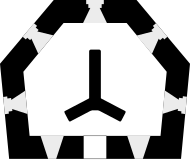Along the way we stumbled upon a cement structure. Curious as to what it was, we "off-roaded" to explore. On our quiet Sunday walk we discovered an actual piece of history. The cement structure was a pillbox, a British hardened field defence for World War II. These were small fortified structures constructed to prepare for invasions and were known as "pillboxes" because of their shape. Two pillboxes are strategically located along the River Cam and near the railway. These were Type 24 pillboxes (there are many different types), which is an irregular hexagon with a rear wall of about 14 feet and other walls vary from 7 to 8 feet. The entrance has an embrasure on either side, suitable for rifles or light machines guns, and embrasures in each of the walls. The walls were built to shell proof standard with walls at least 12 inches thick. Internally there is a Y-shaped anti-ricochet wall with the top of the Y nearest the entrance. See diagram:
Waterbeach itself is a quiet little village with a town green in the center, some shops, a few pubs, and of course the local parish church. What is remarkable, in my opinion, about this small local village church is that it dates to the 12th century. We stood in a church that is over a thousand years old while a young man was practicing on the organ, for what I presumed was the next week's service. The facade of the church is studded with flint, creating a polka dot aesthetic. As explored in yesterday's post, the use of flint in buildings is common for this area.
Before reaching Waterbeach, we also came on a few wild gardens, one called Cow Hollow Wood that we explored by ourselves. Built by volunteers, they returned fallow land to the wild with native plants and put in trails and benches to enjoy the serenity of their creation. While wandering around the wooded area, I couldn't help imagine what all the fields around would have looked like before cultivation and what we would have seen before the cultivation of the land into farms and the building of railways and roadways.
On a Sunday afternoon to go from pre-cultured land, to a 12th century church, to a World War II defense structure was truly an adventure through history.

No comments:
Post a Comment